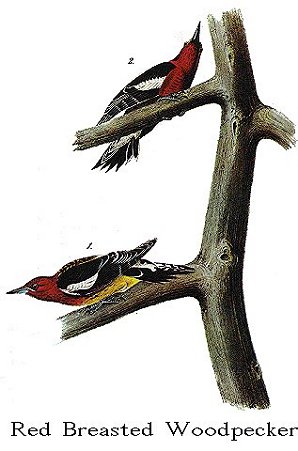
| Family XVI. PICINAE. WOODPECKERS. GENUS I. PICUS, Linn. WOODPECKER. |
Next >> |

Family |
RED-BREASTED WOODPECKER. [Red-breasted Sapsucker.] |
| Genus | PICUS RUBER, Gmel. [Sphyrapicus ruber.] |
Several specimens of this Woodpecker, which were procured by Mr. TOWNSEND
on the Columbia river, are in my possession; but I regret that I have no other
information to communicate respecting its habits than what is contained in the
following note from my friend THOMAS NUTTALL, Esq., who says, "This species,
seen in the forests of the Columbia and the Blue Mountains of the same country,
has most of the habits of the common Red-headed species. It is, however, much
less familiar, and keeps generally among the tall fir-trees, in the dead trunks
of which it burrows out a hole for a nest, sometimes at a great elevation. On
approaching one which was feeding its young in one of these situations, it
Uttered a loud reverberating t'rr t'rr, and seemed angry and solicitous at my
approach. The same species also inhabits Upper California as well as the
north-west coast up to Nootka. It is found eastward as far as the central chain
of the Rocky Mountains." An egg taken from a nest which contained four, is an
inch and a quarter in length, three-fourths in breadth, smooth, equally rounded
at both ends, though somewhat elongated, and pure white.
PICUS RUBER, Gmel. Syst. Nat., vol. i. p. 429. Lath. Ind. Ornith., vol. i.p. 228.
RED-BREASTED WOODPECKER, Picus ruber, Aud. Orn. Biog., vol. v. p. 179.
Male, 8, 14. Female, 8; wing, 5 2/12.
Upper California. Columbia river. Nootka. Common. Migratory.
Adult Male.
Bill about the length of the head, straight, strong, angular, compressed
toward the tip, which is slightly truncate and cuneate. Upper mandible with the
dorsal line very slightly convex, the ridge very narrow, the sides sloping,
concave at the base, slightly convex toward the end, the lateral angle farther
from the ridge than from the margin at its commencement, and terminating on the
edge about half-way, the edges sharp, direct, overlapping. Lower mandible with
the angle short and rather wide, the crural outline straight, the dorsal
ascending and straight, the sides sloping outwards and slightly convex, the tip
narrow. Nostrils linear-oblong, basal, concealed by the feathers, and placed
much nearer the margin than the ridge.
Head rather large, ovate; neck rather short; body full. Feet very short;
tarsus very short, feathered anteriorly one-third down, in the rest of its
extent covered with a few large scutella; sharp-edged and having internally
small scutella behind; toes four; first toe small; fourth slightly longer than
third; second and third united at the base; claws large, much curved,
compressed, laterally grooved, very acute.
Plumage very soft, full, and blended. A tuft of reversed stiffish feathers
on each side of the base of the upper mandible, concealing the nostrils; the
feathers at the angle of the lower mandible also stiffish. Wings rather long;
the first quill very small, being only ten-twelfths long, the second
nine-twelfths shorter than the third, which is two-twelfths shorter than the
fourth, the latter being the longest, and exceeding the fifth by a twelfth and a
half; secondaries rounded, and somewhat emarginate. Tail of moderate length,
cuneate, of twelve feathers, of which the lateral is only eleven-twelfths long,
and one inch five and a half twelfths shorter than the next, which is
eleven-twelfths shorter than the middle, and slightly worn, the rest having the
tip slit, the shaft terminating abruptly.
Bill bluish-grey, dusky toward the end. Feet bluish-grey, claws brown.
The upper part of the head, the neck all round, and a portion of the breast deep
carmine; the tufts over the nostrils yellow, and from them a white band to
beneath the eye; the feathers of the eyelids black; the middle of the breast and
the abdomen yellow; the feathers of the sides of the body and rump, with the
lower tail-coverts, barred, or marked with a pointed dusky spot, their edges
yellowish-white. The upper parts are black, the middle of the back spotted with
yellowish-white, the rump and upper tail-coverts white on the inner webs and
toward the tip on both. There is a large patch of white on the wing, formed by
some of the smaller coverts, the first row of small coverts and the terminal
portions of the outer webs of the secondary coverts. The quills are black, the
three longest with eight spots on the outer and five on the inner web, the
second with four on the inner web and two on the outer, the first with two on
the inner web; the secondaries more or less tipped with white, but several of
them without spots on the outer web. The tail-feathers are black, the two
middle with three or four white spots on the inner web, or white, with several
black bands. Sometimes the lateral feathers are spotted on the outer edge, and
several have a terminal white edging.
Length to end of tail 9 inches; bill along the ridge 11/12, along the edge
of lower mandible 1 1/12; wing from flexure 5 (4 1/2)/12; tail 3 10/12; tarsus
(9 1/2)/12; first toe (3 1/4)/12, its claw (3 1/2)/12; second toe 7/12, its claw
(4 1/2)/12; third toe 8/12, its claw (5 1/2)/12; fourth toe (7 1/2)/12, its claw
(4 1/2)/12.
Adult Female.
The female differs only in having the tints somewhat fainter, the white
markings on the back smaller, and the yellow of the lower parts duller.
Length to end of tail 8 1/4 inches; bill along the ridge 11/12; wing from
flexure 5 2/12; tail 3 7/12.
| Next >> |